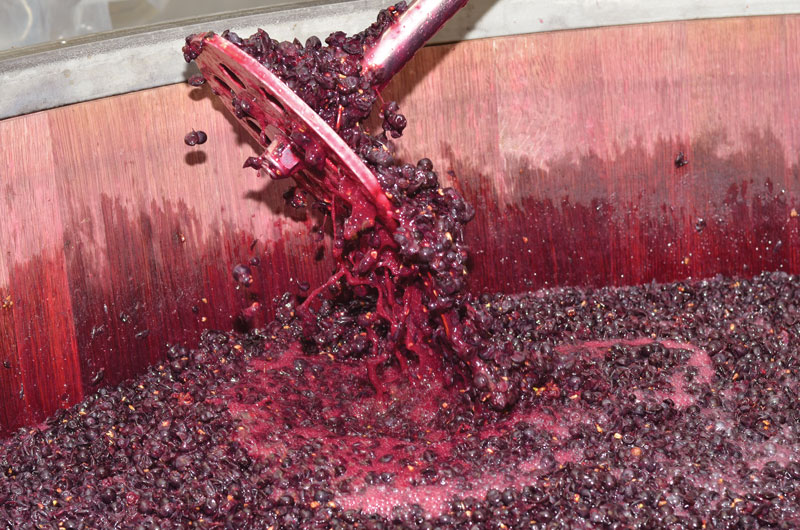Wine Wizard
Freezing Grapes
Goodness, I’ve never answered two questions at the same time before! I decided to put the two of you together since your questions were so similar. There are some things that apply
Curing A Stuck Fermentation
Yes, sluggish and stuck fermentations are one of the most common, persistent, and frustrating issues that winemakers encounter. They happen for so many reasons, and possibly for a combination of so many
Degassing Wine
As you know, the fermentation process (both the initial fermentation turning sugar into ethanol and the secondary malolactic fermentation) produces quite a lot of carbon dioxide gas. The majority of this escapes
Macerating Skin Packs
Ah, kits are getting so clever these days! I would say it all depends on the quality of what you feel, taste, see, and smell for the material that comes in your
Varnish on Mini Barrels
Well, I suppose you could sand the varnish off if you didn’t like it very much . . . but, realistically, I don’t think it’ll affect the wine that much. If you’ve
Vineyard Planning
That is so great to hear that you’ll be planting a vineyard. Welcome to the great Sonoma County viticulture adventure! My company has vineyards in Sonoma too and I’ve been making wine
Quality Control
In deciding to bottle, age or toss this batch, I suggest you spend some quality time with your barrel. Though you’re just past the usual bottling window (typical aging time for premium
Pressing Issues
You’ve hit on one of the classic difficulties of making wine at home. The equipment we use, from presses to barrels to filters, usually are much smaller than that used by commercial
Wine Yeast to Make Bread
You can definitely use wine yeast for baking bread. Bread yeast and wine yeast are both Saccharomyces cerevisiae and both work the same way, by eating sugar and converting it into ethanol
Light Strike in Wine?
I would definitely try to store your wine in the dark if you can. Your wines are in what I’m assuming are clear glass demijohns and over the year or more aging
The New Need For Sanitation
What’s the difference between cleaning and sanitizing? Cleaning refers to the manual removal of dirt, soil, and grime on an item or a surface. Sanitizing is the next step, which, when done
Overcompensating With Copper
Ah yes, Monday morning quarterbacking is always tough when it comes to wine. Adding a complex yeast nutrient (a mix of nitrogen, amino acids, and other micronutrients) is something I do with
Defining “Percent New Oak” in Wine
Thanks for bringing up this topic. There are some parts of the answer that’ll be really obvious but like so much in winemaking, it’s often up for interpretation and the subtleties may
The Safety of Brass Fittings
AYou might be encouraged to know that brass fittings have a long and storied history in winemaking. In fact, if you travel the back roads of Europe and poke your head into
Can I Use An Untoasted Oak Barrel?
What an intriguing question. I’m having some pioneer-prairie-blacksmith-shop fantasy thoughts on how you might be able to toast the inside of your barrel on your own. Depends on how crazy you want
How to Adjust SO2 Levels In Must
For harvest purposes, when adding SO2 to grapes in order to knock down feral yeast and bacteria (with the goal of reducing VA and letting your yeast of choice get a foothold),
Adjusting Acidity in Wine Kits
Wine kits are so wonderful because they tend to be easier and more predictable than just starting from a fresh batch of grapes. Kits have instructions to follow and you’re right, most
Crazy pH Shift
I applaud you for trying fresh winegrapes in your home winemaking, you’re lucky that you are (relatively) close to a fine winegrape growing area like the Santa Ynez Valley. I grew up
High-pH Wine
QIn the above situation, what do you suggest I do? Do you agree that I should conduct MLF on my wines considering their high-pH characteristics? AFirst off, glad your Viognier got better!
Cucumber Wine
Well, according to specific gravity, your cucumber wine (sounds refreshing) is dry. For RS-dry (residual sugar dry) you want to look for an SG of 0.992 and 0.996 on your hydrometer. If
Stabilizing Whites
Indeed, a pH of 2.9 is really low, even for a Sauvignon Blanc, and I think I would definitely de-acidify in that case. With deacidification you’ll always get some kind of precipitation;
What Could Lead To A Stalled MLF
Malolactic fermentations tend to stall, or not catch on at all, due to these seven most common factors: High alcohol: Over 14.5% and most strains will go through slowly. Over 15.5% and
Evaluating Wine “Numbers”
So, stick with me for a little bit as I get a little philosophical for this one as the answer isn’t straightforward but necessitates a little rambling. My frequent readers will know
The Oak Necessities
I hear you about not wanting to drop that kind of cash for a new barrel, especially as a new hobbyist. If you spread the cost of “good use” years for a
Is MLF testing necessary?
You are absolutely right that most wines, especially those that are inoculated and have favorable conditions, will go malolactic (ML) complete within six or eight months of harvest. Even if your area
